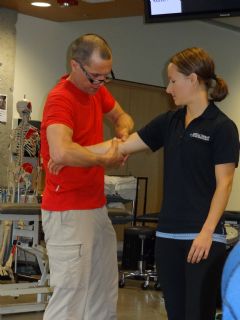Jill & Craig have a long history at the forefront of tendon research & published the continuum of tendon pathology that I have referenced at least a couple of times on this site. Furthermore, the material presented has been updated to include several new proposals, including the modification of the oft prescribed eccentric-based exercise programmes in the management of sub-acute reactive or reactive on degenerative tendon presentations, suggesting that isotonic progressions from the initial isometric loading phase is less provocative.
The main take home message for me was that once the aetiology of the presentation has been identified with a progressive load objective examination being used to compliment an exhaustive history being gleaned in the subjective assessment, the management has to be appropriate & individualised. In the first instance, any acute reactive tendinopathy must be addressed in order to settle down tenocyte activity. This should be done by reducing & modifying activity to a level that allows the inflammatory response to subside, whilst maintaining the maximal non-provocative load to the muscle-tendon unit. Only in the instance of direct trauma should the tendon be completely unloaded.
The modified tendon load should be conducted 2-3 times daily, in a controlled manner, with as heavy a stimulus as possible. As the unit becomes less irritable, the load should be progressed through isometrics, through to slow & heavy isotonics, into a power loading phase & into a high-energy loading phase, initially in a controlled environment & finally in a functionally specific manner. Patience is key!
Bill presented some compelling evidence as to why injection of any medium, be it steroidal or PRP should be avoided at all costs in the management of lateral epicondalgia. A management approach, again based around progressive loading & pain modulation was then discussed to improve the success rate in managing one of the more persistent upper limb pathologies.
Thank you to Jill, Craig & Bill for a thoroughly enjoyable & highly informative weekend.

